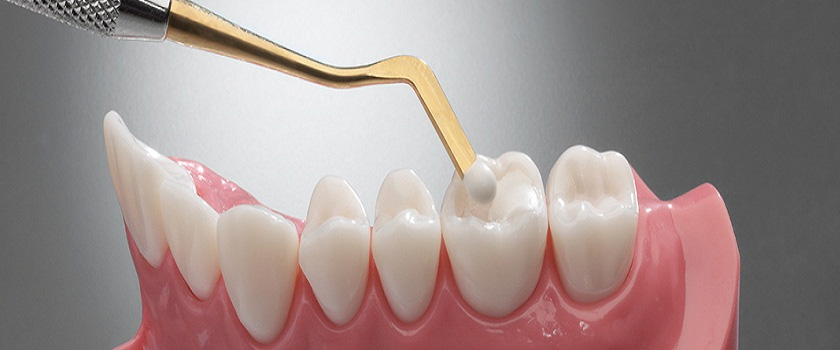General Dentistry
Annual Dental Check-up and Cleaning
Regular exams are an important part of maintaining your oral health.
Your regular exam will take about 45 minutes and will include:
- Checking for any problems that you may not see or feel
- Looking for cavities or any other signs of tooth decay
- Inspecting your teeth and gums for gingivitis and signs of periodontal disease
- Providing you with thorough teeth cleaning, polishing, and rinsing your teeth to remove any tartar and plaque that has built up
Visiting our office every six months gives you the chance to talk to us about any questions you may have about your oral health.

Dental Fillings
Lifelike. Natural
Composite – enhanced resilience with pleasing results

For some time we have been using composite fillings to correct defective or damaged teeth at the front or side of patients’ mouths. This especially hard plastic ceramic has proven invaluable particularly for fillings and aesthetic tooth restorations. Thanks to Composite, repairs are virtually invisible – and the natural tooth remains safely in place.
Dentures
There are two types of dentures: full and partial.
Full dentures are given to patients when all of the natural teeth have been removed. Partial dentures are attached to a metal frame that is connected to your natural teeth and are used to fill in where permanent teeth have been removed. Just like natural teeth, dentures need to be properly cared for.
Use a gentle cleanser to brush your dentures, always keep them moist when they’re not in use, and be sure to keep your tongue and gums clean as well.

Crowns and Bridges
Crowns are most often used for teeth that are broken, worn, or have portions destroyed by tooth decay.
A crown is a “cap” cemented onto an existing tooth that usually covers the portion of your tooth above the gum line. In effect, the crown becomes your tooth’s new outer surface. Crowns can be made of porcelain, metal, or both. Porcelain crowns are most often preferred because they mimic the translucency of natural teeth and are very strong.
Crowns or onlays (partial crowns) are needed when there is insufficient tooth strength remaining to hold a filling. Unlike fillings, which apply the restorative material directly into your mouth, a crown is fabricated away from your mouth. Your crown is created in a lab from your unique tooth impression, which allows a dental laboratory technician to examine all aspects of your bite and jaw movements. Your crown is then sculpted just for you so that your bite and jaw movements function normally once the crown is inserted.

Root Canal Treatment
Today, with a special dental procedure called “root canal treatment”, your tooth can be saved.
When a tooth is cracked or has a deep cavity, bacteria can enter the pulp tissue and germs can cause an infection inside the tooth. If left untreated, an abscess may form. If the infected tissue is not removed, pain and swelling can result. This can not only injure your jawbones, but it is also detrimental to your overall health.
Root canal treatment involves one to three visits. During treatment, your general dentist or endodontist (a dentist who specializes in problems with the nerves of the teeth) removes the affected tissue. Next, the tissue will be removed, and the interior of the tooth will be cleaned and sealed. Finally, the tooth is filled with a dental composite. If your tooth has extensive decay, your doctor may suggest placing a crown to strengthen and protect the tooth from breaking. As long as you continue to care for your teeth and gums with regular brushing, flossing, and checkups, your restored tooth can last a lifetime.

Tooth Extraction
Pulling out a tooth is a common procedure that’s recommended when a tooth is too rotten or too damaged to restore. Teeth are not rigidly fixed to the jaw bone. They’re connected to the bone by fibers called periodontal ligaments. By carefully manipulating a tooth, the ligaments can be dislodged and the tooth can be pulled out.
Why a Tooth May Need to be Removed?
There are several reasons why people come to Summit Dental Care to have a tooth removed. Common reasons for pulling teeth include:
Often a tooth that has been cracked or broken due to an accident or injury can be restored by placing a cap over the tooth, known as a crown. When the damage to the tooth has reached the connective tissue in the middle of the tooth, called the pulp, a root canal may be required before the tooth is capped. There are times, however, when it’s not possible to restore the damaged tooth and it must be removed.

Teeth Whitening
An overview
Over time teeth can become discolored with lifestyle habits such as smoking, soda, tea, wine and coffee consumption. In office whitening procedures uses the whitening technology to get teeth white, fast.
Patients also have the option of convenient in home whitening. We provide custom trays to fit over your teeth over an extended period of time. This is also recommended for maintenance of a white bright smile, after in office whitening.
Patients who are very sensitive can be provided with fluoride treatments before and after the procedures.
There are many systems and products available today that can help whiten your teeth, but none are more powerful than the procedures used in the dentist office. In-office bleaching is the fastest way to whiten your teeth.
